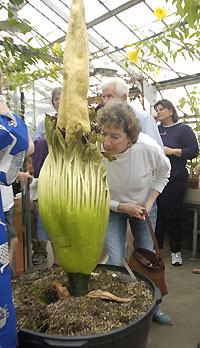For more archives, go to the Advance Archive/Search Page.
Rare Bloom Draws Curious Crowds To Campus
Never before had so many come so far to smell something so bad at the University of Connecticut.
 |
Barbara Fazzino of Andover smells the titan arum in the biology greenhouse.
|
Earlier this month, more than 21,000 plant enthusiasts and curiosity-seekers from across the Northeast and beyond traveled to the ecology and evolutionary biology greenhouse to view the blooming of the world's most malodorous plant.
The titan arum is a tropical plant that springs from a huge underground tuber and features a gigantic bloom and a mighty stench. The last time Amorphophallus titanum (titan arum) opened in the Northeast was in the 1930's, at the New York Botanical Garden.
Fewer than five dozen have flowered in the United States since the titan arum bloomed for the first time in cultivation at the Royal Botanic Gardens in Kew, England, in 1889.
Starting in late June, for three weeks UConn's Conservatory became the greenhouse community's "ground zero." At first, a trickle of people who had heard about the plant began to make their way to the greenhouse behind the Torrey Life Sciences Building. As the media began to report the story, the trickle became a steady flow, as thousands descended on Storrs to glimpse the "stinky plant."
Researchers set up a Web cam on the University's website to provide continuous coverage of the plant's progress. More than two million hits were recorded by the time it bloomed July 6. A guest book set up in the greenhouse recorded visitors from as close as Willimantic and Torrington and as far away as Buenos Aires, Argentina, and Paris, France.
UConn's titan arum plant was started 10 years ago from a seed the size of a lima bean.
"It's been a learning experience," says Clint Morse, plant growth facilities manager at UConn, who obtained and planted several titan arum seeds. "A great deal remains unknown about the plant because it is difficult to find in the wild, and especially hard to find flowering. So much of what we know about this plant is anecdotal. We're trying to gather and document as much scientific information as we can."
Morse coaxed UConn's flower bud to grow more than five feet high and eventually to commence its bloom. Unlike other bloomings, the plant's spathe, or bloom, only opened partially for one day, releasing its intense offensive odor. It closed in the early hours of July 7, and did not reopen.
"It is highly likely that the flower closed due to cool temperatures in the greenhouse, and that those cool night temperatures also led to the delayed opening," said Morse. The plant was expected to flower in late June.
The titan arum is native to the equatorial rainforests on the Indonesian island of Sumatra, where it is known as bunga bangkai, the corpse flower. Plants grow from a potato-like underground tuber, which produces umbrella-shaped leaves 10 feet high and 15 feet across. Only a single leaf is present at any one time, but it is dissected into many smaller leaflets. The whole looks something like a palm tree. A leaf can last for several years, quietly capturing sunlight and storing food in the tuber, before it withers and is replaced. After the tuber has grown to weigh as much as an average man, the corpse flower blooms.
The flower blooms directly from its tuber, in between cycles of leaf production (like an amaryllis). The flower is about six feet high and three feet across, shaped like an urn, with a tall spike rising from the center. (Technically, this is a composite of many small flowers, but it looks like one gigantic flower.) It is similar in shape to the flowers of local woodland plants like jack-in-the-pulpit and skunk cabbage, or to calla lilies, all of which are distant relatives.
The corpse flower is specifically adapted to attract carrion flies and beetles, which ferry pollen between plants so they can produce seed. The colors of the corpse flower - a sickly yellow and blackish purple - imitate rotten meat. The smell is powerful and unpleasant, with elements of old socks, dead fish, and rotten vegetables. In addition, the corpse flower is warm-blooded, heating itself up at the height of flowering, probably to help spread its putrid odor. It is irresistible to flies, which are tricked into thinking they've chanced upon a dead animal, and thus help pollinate the plant.
The rarity and unusual features of the titan arum demand the attention of anyone who sees it, illustrating the multiple functions of biology greenhouses, says Gregory Anderson, professor and head of ecology and evolutionary biology.
"The plants we grow fit our mission to emphasize biodiversity," he says. "The conservatory is a vital part of our teaching program, a place where we can expose students to the diversity of the world's plants. In instances like this flowering event, we are also able to reach out to the public to shine a spotlight on things not ordinarily seen.
"Some 50 classes at UConn utilize the collections, everything from biology labs in need of plants to dissect, to art students seeking something beautiful to sketch in January," Anderson says. "The same plants are part of the research of faculty and graduate students studying plant ecology, conservation, development, or biodiversity."
While the corpse flower is uncommon and difficult to locate in Sumatra, it is also rare in cultivation. Recent greenhouse flowerings in California, Washington, D.C., and London have attracted international media coverage and thousands of visitors.
Morse attributes the more recent bloomings to the work of Dr. James Symon, a medical doctor and amateur botanist who sought to popularize the plant. Symon collected the seeds and distributed them to botanical gardens and university greenhouses around the country, including UConn. Because of his efforts, the titan arum has bloomed in the United States nearly every year since 1998.

